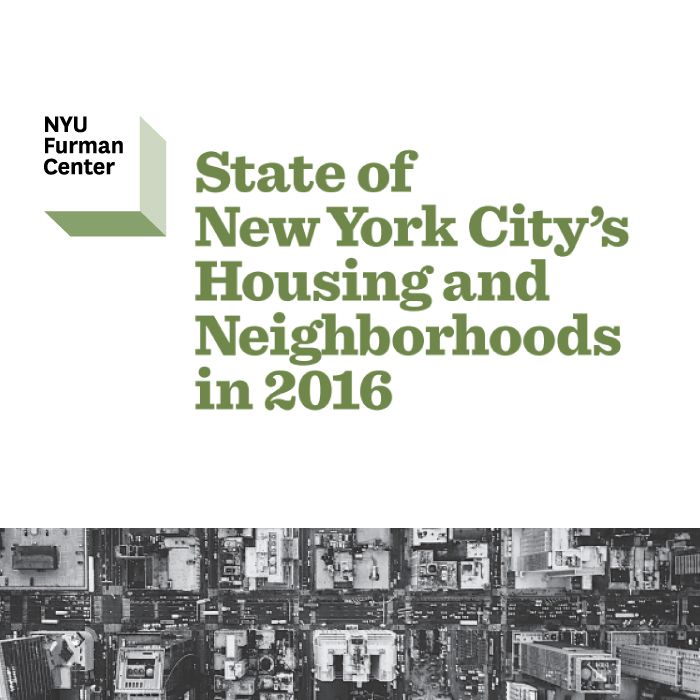
State of New York City’s Housing and Neighborhoods in 2016

The State of New York City’s Housing and Neighborhoods report, published annually by the NYU Furman Center, provides a compendium of data and analysis about New York City’s housing, land use, demographics, and quality of life for each borough and the city’s 59 community districts. Indicators are available for download on CoreData.nyc.
Each year, the report describes, contextualizes, and provides analysis on a pressing and policy-relevant issue affecting New York City. In 2016, the report focuses on the rising number of New Yorkers living in poverty and the characteristics of neighborhoods where poor households reside. Read key findings from the Focus on Poverty report.
READ THE REPORT: State of New York City’s Housing and Neighborhoods in 2016 (PDF) or the Focus on Poverty (PDF)
ACCESS THE DATA: All information in the State of New York City's Housing and Neighborhoods in 2016, plus expanded indicators and historical data, is available for download on CoreData.nyc.
LAUNCH EVENT: To mark the release of the State of New York City’s Housing and Neighborhoods in 2016 report, the NYU Furman Center will host By the Numbers: Concentrated Poverty on June 7, 2017 from 4:00-5:45 p.m. EDT at NYU School of Law. Watch the livestream >>
Citywide Analysis: Key Findings
State of New Yorkers
Citywide, the share of the population aged 65 or older grew from 11.7% to 13.2% between 2000 and 2015. The senior share of the population grew most dramatically in Manhattan and Staten Island.
The share of households with children declined citywide from 34% to just below 30% between 2000 and 2015, with the largest declines in Brooklyn and Queens.
A larger share of New Yorkers were employed in 2015 than in 2005, before the recession. The share of working age New Yorkers who were unemployed in 2015 was down 2.2 percentage points from 2010 and 0.4 percentage points from pre-recession figures in 2005. Citywide, median household income increased 5% between 2014 and 2015, the largest year-over-year increase in a decade.
State of Land Use and the Built Environment
In 2016, there was a sharp citywide decrease in the number of permits issued for new housing units compared to the previous year. However, while far fewer units in larger buildings were permitted in 2016 than in the previous year, the number of authorized units in one- to four-unit buildings increased 5% over the same period.
Last year, the city designated 40 individual and interior landmarks across all five boroughs, up from the 6 landmarks designed in 2015.
State of Homeowners and Their Homes
Home prices continued to rise in every borough between 2015 and 2016, with a citywide price increase of just over 5%. The Bronx had the largest rate of growth over that period (9.4%) and Manhattan saw the smallest increase in home prices (2.8%).
Property sales volume declined across all property types in 2016. Rental units with five or more units experienced the largest decrease in sales between 2015 and 2016, followed by condominiums.
State of Renters and Their Homes
Median income of renters rose faster than median rent in 2015, for the first time in three years. However, renters’ median income has not recovered to its pre-recession level, while rents have continued an upward trajectory even through the recession. Rents increased in all five boroughs between 2005 and 2015, with Manhattan experiencing the largest increase in median gross rent (27.9%) followed by Brooklyn (20.5%), the Bronx (16.2%), and Queens (15.2%).
The citywide median asking rent in 2016 was $2,795. Median asking rent in parts of Brooklyn and lower and midtown Manhattan were double the median asking rent in most Bronx neighborhoods. Fewer rental units citywide were affordable to low- and moderate-income households in 2015
State of Neighborhood Services and Conditions
Student performance in math improved in all boroughs between 2015 and 2016, though the large disparity between the Bronx and other boroughs persisted. The highest math proficiency rates were in Queens (43.2%) and Manhattan (43.1%) while, in the Bronx, only about one in five students (21.4%) performed at grade level in 2016. Citywide, the share of students performing at grade level in math increased slightly between 2015 to 2016 from 35.2% to 36.4%; the share of students citywide performing at grade level in English Language Arts (ELA) increased by nearly eight percentage points between 2015 and 2016, from 30.4% to 38.0%. .
High school graduation rates improved in all five boroughs in 2016. Citywide, 69.6% of the high school Class of 2016 graduated by June of their senior year.
Serious crime rates continued to decline citywide in 2016. The serious crime rate declined from 12.9 crimes per 1,000 residents in 2015 to 12.2 crimes per 1,000 residents in 2016. The crime rates for both serious violent crimes and serious property crimes fell in all five boroughs between 2015 and 2016.
Bus ridership dropped significantly in 2015 while subway ridership remained steady.
Average weekday bus ridership dropped in 2015, continuing a trend of decline since 2008. Subway weekday ridership has grown consistently between 2010 and 2015, with an increase of about 50,000 average weekday rides (1%) between 2014 and 2015.
READ THE REPORT: State of New York City’s Housing and Neighborhoods in 2016 or the Focus on Poverty
ACCESS THE DATA: All information in the State of New York City's Housing and Neighborhoods in 2016, plus expanded indicators and historical data, is available for download on CoreData.nyc.
LAUNCH EVENTt: To mark the release of the State of New York City’s Housing and Neighborhoods in 2016 report, the NYU Furman Center will host By the Numbers: Concentrated Poverty on June 7, 2017 from 4:00-5:45 p.m. EDT at NYU School of Law. Watch the livestream >>


